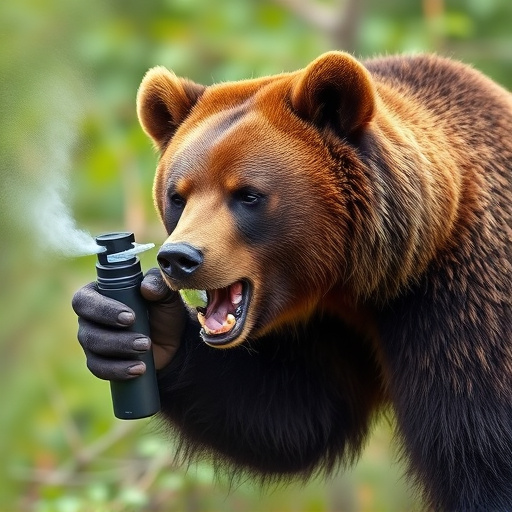Black bears' intelligence and adaptability pose challenges in behavior prediction, but understanding their sensory abilities and triggers is key to safety. Bear spray, a specialized pepper spray, effectively deters them up to 30 feet (9 meters) through eye and respiratory irritation without causing permanent harm. The cloud dispersal range depends on concentration, active ingredients like capsaicin, and environmental conditions. Using bear spray correctly—aiming from 20-30 feet, targeting face, nose, and eyes—maximizes its effectiveness during encounters, crucial for hikers, campers, and anyone in bear-active areas.
“In areas where black bears roam, knowing how to defend yourself is crucial. This comprehensive guide delves into the world of bear spray, a popular and effective deterrent. We’ll explore ‘bear spray cloud dispersal range’ and factors that influence its efficacy. From understanding black bear behavior to best practices for application, this article equips you with vital knowledge. Learn how to make informed decisions when facing potential bear encounters and ensure your safety in the wild.”
- Understanding Black Bear Behavior and Spray Use
- What is Bear Spray and How Does It Work?
- Factors Affecting Cloud Dispersal Range of Bear Spray
- Best Practices for Using Bear Spray Effectively
Understanding Black Bear Behavior and Spray Use
Black bears are wild animals known for their intelligence and adaptability, which can make predicting their behavior challenging. Understanding their habits is crucial when considering defense against black bear encounters. These bears have an exceptional sense of smell, hearing, and vision, allowing them to detect food sources from far away. They are primarily herbivorous but can become predatory if hungry or threatened.
Bear spray, a popular defense mechanism, creates a cloud dispersal range that temporarily incapacitates the bear by irritating its eyes and respiratory system. When used correctly, it provides a critical window of opportunity for retreat. The spray’s effectiveness relies on understanding the bear’s behavior; for instance, avoiding direct eye contact and moving slowly can help prevent triggering an aggressive response. Knowing the spray’s cloud dispersal range ensures users are prepared to back away at safe distances, allowing bears to escape while deterring potential attacks.
What is Bear Spray and How Does It Work?
Bear spray, also known as bear repellent, is a specialized pepper spray designed to deter and protect against black bears. It’s a crucial tool for hikers, campers, and anyone venturing into areas known for bear activity. Unlike traditional pepper spray, bear spray is formulated to create a large spray cloud that can cover a distance of up to 30 feet (9 meters), providing a safety buffer between you and the bear.
When used correctly, bear spray irritates the bear’s eyes, nose, and respiratory system, temporarily disorienting it and encouraging a quick retreat. The spray is designed to be non-lethal but powerful enough to stop an aggressive encounter. The key to its effectiveness lies in its unique composition and dispersion range, allowing users to create a protective barrier without causing permanent harm to the animal.
Factors Affecting Cloud Dispersal Range of Bear Spray
The cloud dispersal range of bear spray is influenced by several key factors that determine its effectiveness in deterring black bears. One primary consideration is the spray’s concentration and active ingredients. Bear sprays are formulated with capsaicin, the same compound that makes chili peppers spicy, or other irritants. A higher concentration ensures a more potent solution, allowing for a greater dispersal range as it can reach and irritate bears at a farther distance.
Environmental conditions play a significant role too. Wind direction and speed can significantly impact how far the spray cloud travels. Tailwind aids in propelling the spray particles further, while headwinds may limit its range. Additionally, temperature and humidity levels affect the spray’s behavior; warmer temperatures tend to reduce viscosity, allowing for better dispersion, while higher humidity can impact the spray’s ability to stick to surfaces, potentially reducing its overall effectiveness.
Best Practices for Using Bear Spray Effectively
When using bear spray, understanding its cloud dispersal range and optimal application techniques is key to effectiveness. Aim directly at the bear’s face, nose, and eyes from a distance of 20-30 feet (6-9 meters). This range ensures maximum coverage while allowing you enough space for safety. Spraying too close may result in missing your target or inhaling the spray yourself.
Remember, the goal is to create a disorienting cloud that interrupts the bear’s behavior pattern. Do not expect a direct hit; instead, focus on achieving a dense spray mist across the animal’s face. Practice using bear spray in controlled environments, like training ranges, to familiarize yourself with its application and enhance your skills for real-world encounters.
In understanding black bear behavior and the effectiveness of bear spray, it’s clear that proper usage is key. By considering factors like cloud dispersal range and best practices, individuals can enhance their defense mechanisms in bear country. Armed with knowledge about what works and what doesn’t, outdoor enthusiasts can take proactive steps to ensure safer encounters with these powerful animals, making every hike and camping trip more enjoyable and secure.
